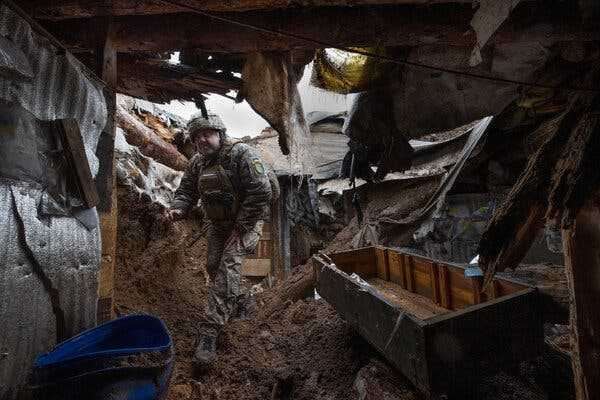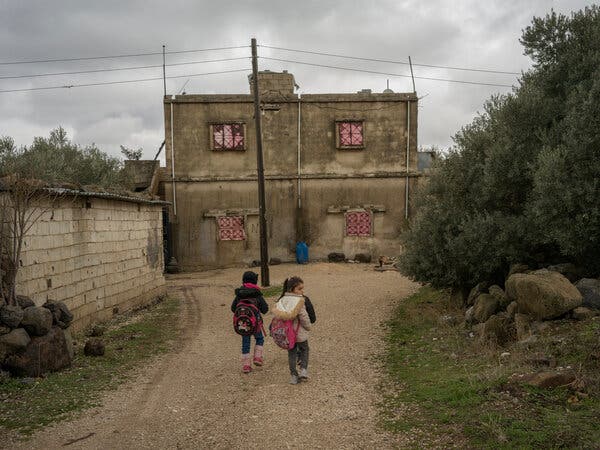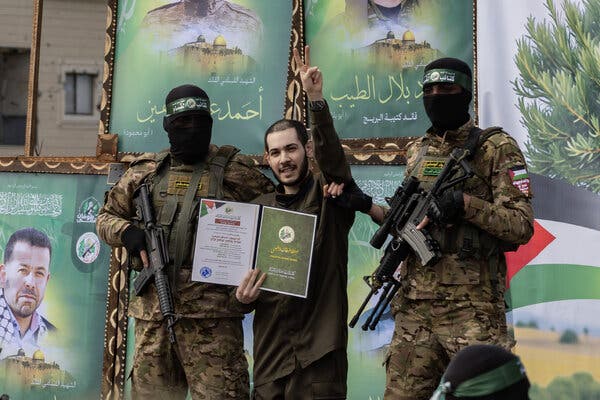President Biden spoke amid fears that Russia was setting the stage for an invasion that could ignite the biggest conflict in Europe in decades.

A Ukrainian military front-line position on Friday near Troitske, in the eastern separatist region of Luhansk, after being hit by an overnight mortar attack.Credit…Tyler Hicks/The New York Times
The force includes 120 to 125 battalion tactical groups, up from the mid-80s earlier in the month. And some of the forces are Russian reservists who would make up an occupation force after an invasion, the officials said. The officials asked for anonymity to discuss government assessments.
Mr. Biden vowed that the United States and its allies were united behind imposing severe economic sanctions if Russia’s forces cross Ukraine’s borders. He said he also held a call with Democratic and Republican lawmakers who expressed united support for the administration during a visit to Munich for a security conference.
In Ukraine, the head of the country’s Ministry of Defense said the claim of an imminent attack by its military was categorically false and intended to inflame tensions. But the ministry issued a stark warning to residents of the contested regions “not to leave their homes and not to use public transport.” It cited “information that Russian special services have mined a number of social infrastructure facilities in Donetsk,” with the aim of “destabilizing the situation” there.
Live Updates: Russia-Ukraine Tensions
Updated Feb. 18, 2022, 7:26 p.m. ET
- Videos show reported explosions near Luhansk.
- What videos reveal about tensions in Eastern Ukraine.
- Multinationals in Ukraine are ready for a conflict but staying put.
The warning reflected how Russia appeared to be pulling out all the stops to pressure the Ukrainians short of sending its troops across the border.
ImageEastern Ukraine on Friday. Credit…Lynsey Addario for The New York Times
The fears of brewing conflict were reinforced as U.S. officials said that as many as 190,000 troops and aligned militias were arrayed in and near Ukraine, a number that includes the separatists. The assessment was delivered in a statement by the U.S. mission to the Organization for Security and Cooperation in Europe, which called it “the most significant military mobilization in Europe since the Second World War.”
Consistent with Russia’s contradictory messaging throughout the crisis, however, Mr. Putin said on Friday that he was prepared for further diplomacy. The announcement of the meeting between Mr. Blinken and the Russian foreign minister, Sergey V. Lavrov, calmed jittery markets and suggested that there was still hope for the crisis to be resolved without war.
But Mr. Putin emphasized that Russia would continue to insist on far-reaching demands for “security guarantees” in Eastern Europe that the West has rejected — such as a halt to the eastward expansion of NATO and the pullback of the alliance’s forces from the region.
“We are ready to go on the negotiating track under the condition that all questions will be considered together, without being separated from Russia’s main proposals,” Mr. Putin said in a news conference alongside his close ally President Aleksandr G. Lukashenko of Belarus, who was visiting Moscow.
Friday’s drumbeat of alarms from the separatists about Ukrainian provocations aligned with how Western officials have been warning that a “false flag” incident could be used to start a military conflict.
ImageA Ukrainian military position near Troitske that was hit by mortars.Credit…Tyler Hicks/The New York Times
In calling for people in the contested areas to evacuate to Russia, Denis Pushilin, the pro-Moscow leader of the Donetsk People’s Republic, offered a stark version of what might be coming in citing supposed provocations by Ukraine.
Understand the Escalating Tensions Over Ukraine
Card 1 of 5
A brewing conflict. Antagonism between Ukraine and Russia has been simmering since 2014, when the Russian military crossed into Ukrainian territory, annexing Crimea and whipping up a rebellion in the east. A tenuous cease-fire was reached in 2015, but peace has been elusive.
A spike in hostilities. Russia has been gradually building up forces near its border with Ukraine, and the Kremlin’s messaging toward its neighbor has hardened. Concern grew in late October, when Ukraine used an armed drone to attack a howitzer operated by Russian-backed separatists.
Preventing an invasion. Russia called the strike a destabilizing act that violated the cease-fire agreement, raising fears of a new intervention in Ukraine. Since then, the United States, NATO and Russia have been engaged in a whirlwind of diplomacy aimed at averting that outcome.
The Kremlin’s position. President Vladimir V. Putin of Russia, who has increasingly portrayed NATO’s eastward expansion as an existential threat to his country, said that Moscow’s growing military presence on the Ukrainian border was a response to Ukraine’s deepening partnership with the alliance.
Rising tension. Western countries have tried to maintain a dialogue with Moscow. But the Biden administration warned that the U.S. could throw its weight behind Ukraine in case of an invasion. France, Germany and Poland also warned Russia of consequences if it launched incursions into Ukraine.
“Very soon, President of Ukraine Volodymyr Zelensky will order the military to go on an offensive, to implement a plan to invade the territory of Donetsk and Luhansk people’s republics,” he said in a video posted online, offering no evidence.
Kyiv firmly denied Moscow’s accusations. And in his remarks Friday, Mr. Biden said there was “no evidence” behind them.
Although Moscow insists that it has no plans for an invasion, it has vowed to mount “a tough response” if the United States and its NATO partners do not roll back their presence in Eastern Europe.
In a demonstration of strength, Russia plans major drills this weekend that will include the launch of ballistic and cruise missiles, the country’s Defense Ministry said, according to the Interfax news agency.
Russia’s drills will test its strategic nuclear forces, which include the land-based launchers, bombers and warships used to deliver nuclear weapons. They will involve the Black Sea Fleet, which has been engaged in large-scale exercises in the region bordering Ukraine. Mr. Putin will preside over them from a “situation center,” the Kremlin said.
The Defense Ministry said the drills had been planned in advance, and Dmitri S. Peskov, Mr. Putin’s spokesman, denied that they were intended to raise tensions with the West. But they will come at a critical juncture in the standoff over Ukraine.
ImageA destroyed outdoor kitchen in the village of Vrubivka, Ukraine, on Friday. It had been struck by artillery fire the day before.Credit…Lynsey Addario for The New York Times
Near the front in Ukraine, it was possible to hear the blasts from munitions fired by the Ukrainian military and incoming fire from the pro-Russian separatists.
A total of 12 houses were damaged by shelling Friday morning, said a local branch of the United Nations High Commissioner for Refugees.
In remarks before Ukraine’s parliament, the country’s defense minister, Oleksiy Reznikov, urged Ukrainians living in the separatist-held territory not to believe Russian propaganda that the Ukrainian government was going to attack them.
“Don’t be afraid,” he said. “Ukraine is not your enemy.”
An estimated 3.5 million people live in the two breakaway regions, and self-declared republics, and since the war started there, Russia has handed out citizenship to more than 700,000 people living in the Donbas region. In his messaging on Ukraine, Mr. Putin has warned of the plight of ethnic Russians in the country, saying that events in eastern Ukraine “resemble genocide.”
Highlighting the growing risk of military conflict, Britain announced Friday night that it was following the United States’ lead in evacuating its embassy from Kyiv to the western city of Lviv.
With fears running high that Russian troops in Belarus could invade Ukraine from the northern border with Belarus, only 140 miles from the capital, the Ukrainian authorities ordered the site of the Chernobyl nuclear disaster closed to tourists.
Valerie Hopkins and Marc Santora reported from Kyiv, Ukraine, and Ivan Nechepurenko from Moscow. Eric Schmitt contributed reporting from Washington.
Source: nytimes.com



